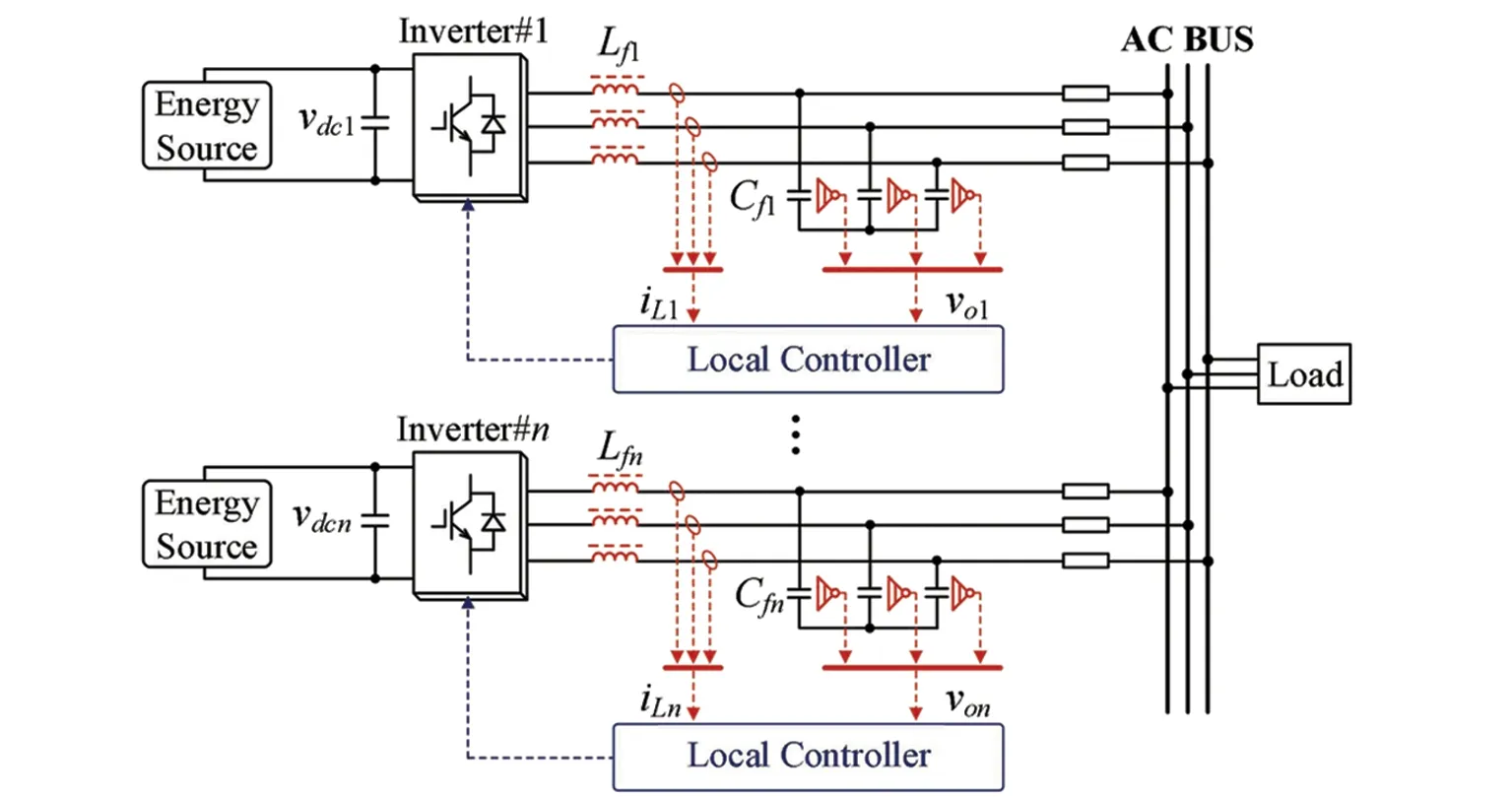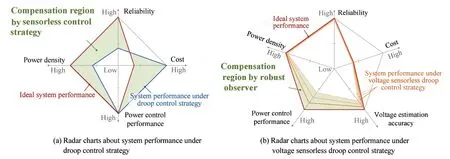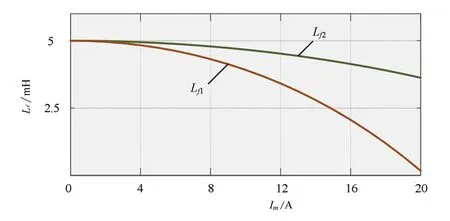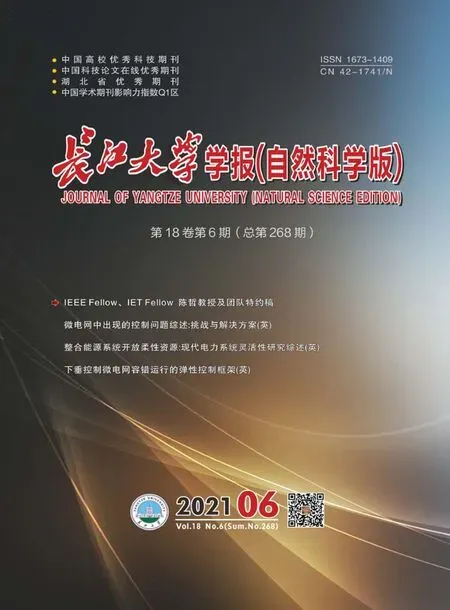A resilient control framework of droop-controlled microgrids for fault-tolerant operation
2021-02-16WANGYanboRUANWenbinCHENZhe
WANG Yanbo, RUAN Wenbin, CHEN Zhe
Department of Energy Technology, Aalborg University, 9220, Aalborg, Denmark
[Abstract]This paper presents a resilient control framework to implement power control in a cost-effective way.Sensorless control strategy is developed to perform desirable power control in microgrids considering nonlinear filter inductors.A virtual flux (VF) model is first established to estimate output voltage signal so that practical voltage sensors can be removed.Then, the effect of nonlinear filter inductor on voltage estimation accuracy is analyzed, and a robust observer-based VF method is developed to mitigate this effect.Furthermore, a robust observer-based voltage sensorless droop control method is developed by adopting voltage estimation in power control and voltage control loops.Simulation results show that the proposed control strategy is able to perform desirable power control performance without using voltage sensors.And the proposed controller has a sound capability to mitigate the effect of nonlinear inductor, which thus improves system reliability and reduces design cost of microgrid.
[Key words]voltage sensorless droop control;VF-based voltage reconstruction;fault-tolerant capability;AC microgrid
1 Introduction
The increasing exploitation of renewable energy sources is promoting development of distributed power generation systems like microgrid, where three-phase voltage source converters (VSC) with LC filter have been frequently adopted as important interfaces[1,2].
The typical architecture of AC microgrid is shown in Fig.1, where control tasks are usually performed in a hierarchical manner.Local controllers are used to perform power control and voltage/current control according to the reference values from energy management system (EMS).And EMS is responsible for the reliable, secure and economical operation of microgrids.In fact, a microgrid tends to be used to supply reliable electricity for critical loads, such as UPS application, ship microgrid and aircraft power system[3,4].Therefore, long-term reliability is becoming essential concern in power conversion systems and one of indispensable constraint of EMS.However, there exist many potential failures in real power system caused by hardware or controllers, which can result in critical system breakdown, maintain cost and energy loss.Fig.2(a) shows the downtime of PV system during 5 years.It can be seen that the majority of system breakdown events are caused by inverter failure, which is mostly associated with the damage of hardware such as sensors, power devices and PCB boards[5].Fig.2(b) shows the distribution ratio of subsystems failure in wind turbines[6].It can also be seen that the failure rate of control system of wind turbines is high, where the downtime caused by sensor failure takes up about 27%.Furthermore, sensor-based control strategies can be disabled once the failure of sensors happens.Therefore, fault-tolerant operation of power converter is essential to mitigate the effect of sensor faults on system reliability[3].

Fig. 1 The architecture of AC microgrid图1 交流微电网结构图

Fig.2 The contribution of subsystems to overall failure rate图2 各子系统对总故障率的点比图
With the characteristics of enhancing system fault-tolerant capability, sensorless control methods have been paid increasing attentions in recent work[7-21].The application of sensorless control strategies is attractive and promising because of the following advantages[7,8].
1.1 Cost reduction
The sensors cost takes up a significant part in total cost in mid/low power converter[7,8].Sensorless operation can reduce effectively the hardware cost of power converter.In addition, the downtime cost and maintenance cost related with sensor failure can be reduced.
1.2 Power density improvement
Without using sensors, the sampling circuits and signal conditioning circuits can be removed, so that the power density of power converter can be improved.
1.3 Reliability enhancement
Sensorless control methods can perform power control without using sensors, which means sensorless controller can be enabled with sensor failures, preforming improved system reliability.
Due to the aforementioned merits, sensorless control strategies have been intensively proposed to reduce the number of the voltage or current sensors in power converters.As an invited paper, this paper first reviews sensorless control strategies in power converters, and displays contributions of our previous work[22].
2 Problem formulation and motivation
2.1 Review of droop control strategy
Fig.3 shows the circuit configuration of an islanded microgrid with multiple paralleled inverters, where droop control strategy is widely applied because of high reliability and flexibility, which can be given as[23]:

(1)

Fig.3 The circuit configuration of the islanded AC microgrid with the multiple paralleled inverters图3 多逆变器并列运行的交流微电网离网控制电路图

(2)
(3)
(4)
Where:voi_αandvoi_βare inverter output voltage inαβframe;iLi_αandiLi_βare inverter output current inαβframe.
Droop control strategies are able to perform desirable power sharing without using critical communication facilities.However, output voltage measuring is necessary in both power control loop and voltage control loop, leading to a high dependence on voltage sensors.A fair comparison in terms of comprehensive performance indexes is shown in Fig.4 for system under droop control strategy and voltage sensorless control strategy.Fig.4(a) shows performance of droop-controlled system, which tends to have characteristics of high cost, low power density and low reliability.Fig.4(b) shows system performance under voltage sensorless control strategy.It can be seen that lower cost, higher power density and higher reliability are achieved.However, power control performance can be effected by the voltage estimation accuracy.Therefore, the vision of this work is to develop a robust observer-based voltage sensorless droop control strategy to perform power control without using voltage sensors, so that the ideal system performance can be achieved in a cost-effective way as shown in Fig.4.

Fig.4 The operation performance of system under different control strategies图4 不同控制策略下的运行特性
2.2 Review of sensorless control methods
Various sensorless control techniques have bene frequently developed in inverter-fed generator and power system, such as doubly-fed induction generator (DFIG)-based wind turbine[9-11], grid-connected photovoltaic (PV) inverters[12-14], grid-connected converters[8,15-17]and individual voltage source inverter (VSI).Sensorless control methods are initially applied in doubly-fed induction machine to perform decoupled power control without rotor position sensors[9-11].Then, various sensorless maximum power point tracking (MPPT) techniques are proposed for grid-connected PV inverters, including indirect current sensorless MPPT control strategies[12], converter topology-based current sensorless MPPT techniques[13]and irradiance/temperature sensorless estimation technique[14].For gird-connected converters, a direct-power-control-based sensorless control strategy is initially proposed in ref.[15], then other strategies are developed by virtual flux (VF) concept[16], Kalman filters[17]and observer-based methods[8]for a lower noise sensitivity.Furthermore, these sensorless control strategies have been paid many attentions in individual inverter[18-20].A voltage RMS controller is developed for single-phase standalone inverter in ref.[18], where VF method is adopted to perform stable closed-loop control without output voltage sensor.A current sensorless finite-set model predictive control (MPC) strategy is developed in ref.[19], where only capacitor voltage sensor is required to achieve favorable voltage quality inLC-filtered voltage source inverter.An observer-based capacitor current sensorless control strategy for a single-phase inverter is presented in ref.[20], where a multi-loop control system is utilized to perform smooth transfer between grid-connected and standalone modes.
However, the aforementioned studies mainly focus on the control of an individual inverter.Sensorless control techniques are slightly applied in droop-conrolled microgrid with multiple inverters, where sensorless control method is attractive for cost saving and reliability improvement.A sensorless power control strategy is presented in our previous work[21], where output current and voltage sensors are replaced by signal estimation technique.However, the effect of nonlinear factors of system like soft-saturation characteristics of filter inductors[24]has not been addressed in previous work[7-21], which could cause a model-mismatch issue, deteriorate signal-estimation accuracy and mitigate system stability.Moreover, in the practical operation of microgrids, filter current sensors are indispensable for overcurrent protection[18].While output voltage sensors can be replaced by voltage sensorless control method for cost saving and reliability enhancement in mid/low power systems.Note that the advantage of voltage sensorless control method is more evident with the increase of inverter number, while for a microgrid withninverters, the cost of sensors with number of 3×ncan be reduced as shown in Fig.3.In high-power systems, although output voltage sensors can not be eliminated because they are also used for many other functions apart from power and voltage control, such as condition monitoring, harmonic monitoring, reliability evaluation, etc.[25], sensorless-operation capability is also critical for high-reliable operation in case of unexpected sensor faults.Therefore, the vision of this work is to propose a resilient control framework by voltage sensorless technique and deal with the effect of nonlinear characteristics on controllers, so that desirable control performance and fault-tolerant capability can be achieved in a cost-effective way.The main contributions of our work[22]can be explained as follows:(1) VF model is established to reconstruct output voltage;(2) The effect of nonlinear inductor on voltage estimation accuracy is analyzed and mitigated;(3) Robust observer-based voltage sensorless droop control strategy is proposed to perform power control without using voltage sensors, obtain a sound capability to reject the effect of nonlinear inductor.
3 Proposed voltage sensorless droop control strategy
3.1 VF-based voltage recontruction method
In this work, VF method is employed to reconstruct output voltage by using DC-link voltage, output current and PWM signals.The definition of VF is originally introduced in ref.[26] as:
(5)
where :ψi_αandψi_βare VF inαβframe;ωfis cut-off frequency of first-order filter;Lfiis the inductance of filter inductor;vi_αandvi_βare PWM converter voltageviinαβframe.Voltageviis given as:
(6)
Where:vdciis DC link voltage of thei-th inverter;Sai,SbiandSciare states of switches of thei-th inverter.
The relationship of amplitude and angle betweenψiandvoiis given as:
(7)
Where:θψiandθvoiare instantaneous phase angles of VF and output voltage.
(8)
3.2 Robust observer-based VF method
The accuracy of voltage reconstruction is critical for system power control performance, which is shown in Fig.4(b).However, it can be seen from and that the voltage estimation is related with the filter inductance, which means that the accuracy of voltage estimation can be deteriorated due to inductance perturbation.The inductance perturbation of filter inductor has been elaborated in our previous work[22]and will be reviewed in this section.
In practical applications, permeability of powder core can be slowly decreased with the increase of inductor current, which can lead to nonlinear characteristics of filter inductors[22].The average nonlinear inductor model is established in[22]as:
(9)
Where:Imis amplitude of output currentiL;aavg, cavgand eavgare parameters of filter inductor which are associated with inductor core material and are given in ref.[22].
Fig.5 shows the practical soft-saturation characteristics of inductors with different powder magnetic cores[27,28]as variation of load powers.It can be seen that the actual inductances of filter inductors (takingLf1andLf2in Table 1 as an example) can be changed with the increase of load current, in which the current-dependent inductance characteristics of two inductors are different due to difference of magnetic materials.

Fig.5 The practical soft-saturation characteristics of inductors with different powder magnetic cores as variation of load powers图5 不同负载功率下不同磁芯电感实际软饱和特性图
In order to mitigate the effect of inductor nonlinearity on voltage estimation accuracy, a robust observer-based voltage estimation method is developed by configuring the average nonlinear inductor model into the VF method as:
(10)
Where:
The process of robust observer-based voltage estimation method is shown in Fig.6(a).It can be seen that a robust observer is employed to predict filter inductance, the voltage estimation process has a sound capability to mitigate the effect of nonlinear inductor.
3.3 Voltage sensorless droop control strategy
Once output voltage is reconstructed, voltage sensorless droop control strategy can be given as:
(11)
(12)
(13)
Fig.6 shows the control diagram of the proposed voltage sensorless droop control strategy.It can be seen that the voltage estimation is adopted in both power control loop and voltage control loop so that voltage sensors can be removed.

Fig.6 The control diagram of proposed controller图6 控制器控制框图
4 Simulation verification
To validate effectiveness of the proposed voltage sensorless droop control strategy, the simulation verification is implemented in a scale-down AC microgrid with two inverters in MATLAB/SIMULINK.Circuit configuration of the exemplified microgrid is shown in Fig.3.The circuit and control parameters applied in the simulation verification are given in Table 1.

Case1: The performance of proposed voltage sensorless droop control strategy
In this case, operation performance of paralleled-inverters under proposed voltage sensorless droop control strategy are tested.Load step is exerted at 2s to validate dynamic performance of the proposed droop controller.Fig.7 and Fig.8 show the results about active and reactive power sharing performance under a conventional droop control strategy and the proposed droop control strategy.It can be seen that the proposed voltage sensorless droop control strategy can implement desirable power sharing performance as compared with the conventional droop control strategy.

Fig.7 The simulation results under the conventional droop control strategy图7 传统下垂控制策略仿真结果

Fig.8 The simulation results under the proposed control strategy图8 控制策略的仿真结果
Case2: The immunity to nonlinearity of filter inductor
In this case, the effect of nonlinear filter inductor on power sharing characteristic is shown, and capability of the proposed controller to mitigate this effect is tested.The VF voltage estimation method without robust observer is enabled during 2~4s and the robust observer-based voltage estimation method is activated during 0~2s and 4~6s.Fig.9 shows the result about power sharing performance.It can be seen that the accuracy of reactive power sharing is deteriorated due to the effect of nonlinear filter inductors.However, once the proposed droop control strategy is activated, the reactive power sharing error can be eliminated and equal reactive power sharing can be implemented.

Fig.9 The simulation result of case 2图9 例2的仿真结果
5 Conclusion
This paper reviews work on sensorless control strategies in power converters and displays our previous work on this topic.A robust observer-based voltage sensorless droop control strategy is presented to implement proportional power sharing with low cost and high reliability.VF model is first established to reconstruct output voltage.Then, a robust observer-based VF method is developed to mitigate the voltage estimation error caused by nonlinear filter inductor.Furthermore, a robust observer-based voltage sensorless droop control method is developed by adopting voltage estimation in power control and voltage control loops.Simulation results show that the proposed robust observer-based voltage sensorless droop control strategy is able to implement desirable power sharing with immunity to the nonlinear perturbation of filter inductor.
猜你喜欢
杂志排行
长江大学学报(自科版)的其它文章
- 一种改进的多任务级联卷积神经网络人脸检测算法
- Opening flexible resources by integrating energy systems: A review of flexibility for the modern power system
- An overview for emerging control issues in microgrids: Challenges and solutions
- 一种新型含沥青质储层解堵液体系的研究
——以四川盆地龙女寺龙王庙储层为例 - 稠油油藏常温水驱自乳化效果评价
——以准噶尔盆地昌吉油田吉7井区为例 - 深部裂缝性碳酸盐岩储层井壁稳定技术研究现状及展望
